Printed in the Fall 2024 issue of Quest magazine.
Citation: Rees, Julian, "Co-Masonry Revealed" Quest 112:4, pg 28-32
By Julian Rees
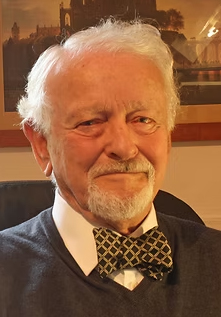 What would you say if you knew there was a worldwide pursuit of nonreligious, secular spirituality over three hundred years old? It is called Freemasonry, a pursuit that has been wrongly characterized in many ways: as a rich men’s social club, as an excuse to dress up in elaborate regalia, as a sinister movement whose aim is worldwide domination, as a charitable foundation whose primary aim is the relief of distress, as a men-only organization acting as a refuge from marital encumbrances, and many more.
What would you say if you knew there was a worldwide pursuit of nonreligious, secular spirituality over three hundred years old? It is called Freemasonry, a pursuit that has been wrongly characterized in many ways: as a rich men’s social club, as an excuse to dress up in elaborate regalia, as a sinister movement whose aim is worldwide domination, as a charitable foundation whose primary aim is the relief of distress, as a men-only organization acting as a refuge from marital encumbrances, and many more.
The truth is quite different. While it is true that worldwide, Freemasonry is largely an all-male pursuit, there is a vibrant branch, existing since 1893, of liberal, nondogmatic, bigender Freemasonry firmly grounded in a spiritual path, the pursuit of self-knowledge, liberty of conscience, the perfection of humankind, equality of men and women, and the erection of an edifice dedicated to the perfection of humanity, harmony and balance, tolerance, and equality.
Paramount amongst these values is self-knowledge. One of the simplest but most important symbols is the point within a circle. Self-knowledge is represented here by access to the still, small point in the interior of each human being.
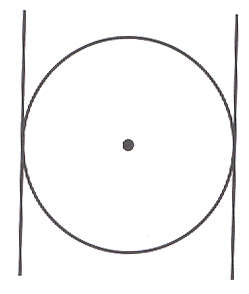
Freemasonry at its richest form of expression is an esoteric pursuit, engaging both men and women in the International Order of Freemasonry for Men and Women Le Droit Humain, whose supreme council is in Paris but which is found in many countries.
This Order started in 1893 when Marie (or Maria) Deraismes (1828‒94), an ardent feminist and proponent of women in Freemasonry, was initiated into a Masonic Lodge in the town of Le Pec near Paris by male Freemasons sympathetic to her cause.
The world of Freemasonry was scandalized at this innovation and refused to accept it. But the founders persevered and initiated even more women, and in this they were supported and energized by Georges Martin. Together with prominent Theosophist Annie Besant, they founded the New Masonic Order. Besant founded the British arm of the Order, and C.W. Leadbeater, another Theosophist, also became a member.
In this Order, a person aspiring to be a Freemason is initiated using a ceremonial with echoes of the ancient Mystery traditions, such as the Mithraic and Eleusinian. Today in our tradition we define Freemasonry as “an initiatory system containing the keys to the ancient mysteries, which are experienced through a series of mystery dramas designed to open up and deepen awareness and understanding.” These mystery dramas are codified in three degrees:
1. The first degree, that of initiation, which is a complex allegory of death of the self in order to be re-born; renewal; acquisition of spiritual light; paths leading to self-knowledge.
2. The second degree, that of passing, incorporating an allegory of the passage through life, and development of the intellectual faculties, while emphasizing the intellect of the heart (intuition) over that of the brain.
3. The third degree, that of raising, is an allegory of death and the human aspiration to triumph over death to be reborn. It is a development of aspects of the first degree.
All three degrees make use of symbolism. The tradition is based on that of stonemasons, from whose symbols allegories are devised. For Freemasons, an allegory is a form of nonverbal communication. To pick a simple example, we have the first degree Freemason, who is called an Entered Apprentice, engaged in allegorically sculpting a rough cuboid stone to make of it a perfect, smooth, six-sided cube. The allegory, which the candidate is personally invited to decode, is that of the perfection of one’s own character. One will meet with many such allegories on this journey.
The First Degree
 |
|
| Tracing Board for 1st Degree. |
|
But first let us begin at the beginning. Once an aspirant has met socially with many members of the lodge, she or he will be balloted for in an open lodge meeting. (Henceforth in this article, the pronoun he should be taken to mean either she or he.) If the ballot is in his favor, he will come to the lodge on an appointed day when he will be prepared for the ceremony of initiation. This preparation consists of disarranging his clothing, removing all money and metallic objects such as jewelry, removing one shoe, placing a blindfold over his eyes, and placing a rope with a running noose about his neck. This allegory is manifold: the candidate comes spiritually devoid of light; he needs to direct his attention inwardly; he comes without material encumbrances; he is submissive; he is disoriented; he places his trust in those around him; they place their trust in him.
At the door of the lodge, the candidate is met with two dangers: one if he tries to rush forward, the other if he is reticent and holds back. This allegory teaches him to persevere steadily. Once inside the lodge, after the Master recites a prayer invoking divine aid, the candidate is led round to be verbally examined by two of the senior officers of the Lodge: the Senior Warden and the Junior Warden. During this perambulation, he is presented to the elementals of earth, air, fire, and water:
Ho! Elementals of the Earth, who guard the right side of the Second Portal. Behold! A blinded child of mortality, seeking Immortality, approacheth. Earth to Earth he gives you of your own. As he thus recognises you, so shall you henceforth always recognise him as one of the Brethren. Open your ranks, that he may come near to the Warden of your Gate.
Finally the candidate is verbally examined by the Master. He then kneels at an altar placed near the center of the lodge and swears a vow of fidelity to Freemasonry and to the lodge in particular.
The culmination of the ceremony of initiation is the presentation of the working tools, which in this degree are the twenty-four-inch gauge, the common gavel, and the chisel. Apart from their operative uses, the allegorical uses are explained to the aspirant. The common gavel represents the driving force of humanity; the chisel passively receives the blows of the gavel but is in itself capable of very fine, creative work; the gauge not only measures the work, but in a figurative sense measures the other two, by allegorically tempering the blows of the gavel and encouraging the chisel to be more assertive.
A summary of this degree might say that the aspirant gives up physical, material freedom in order to attain for a different, greater freedom as a Freemason.
Each degree in Freemasonry uses what is called a tracing board as a means of displaying some of the allegories in a visual form and to encourage meditation on them. The first-degree tracing board shows the sun and moon and seven stars. Beneath those is what is called the Blazing Star, emblematic of the divine presence. Beneath that is Jacob’s Ladder, a conduit between the terrestrial and the celestial, displaying emblems of faith, hope, and charity. The ladder rests on the Bible or another holy book, itself resting on an altar. On the Bible are displayed the square and compasses, and on the front of the altar is the point within a circle mentioned earlier. The three pillars, of the Ionic, Doric, and Corinthian orders, represent wisdom, strength, and beauty respectively. The rough-hewn stone and the polished stone are shown, as are the working tools, the gavel, chisel, and twenty-four-inch gauge, as well as a square, level, and plumb rule, emblematic of morality, equality, and truth. The whole stands on a white and black checkered pavement, representing light and darkness, good and evil, joy and sorrow, fortune and misfortune, life and death.
As mentioned earlier, the second degree deals with the passage through life, the aspirant increasing and developing intellectually and morally. After entering the lodge, the Apprentice passes five stages, named the senses, the arts, natural science, benefactors of humanity, and service:
1. The senses are touch, hearing, sight, taste, and smell.
2. The arts mentioned are architecture, sculpture, painting, music, and poetry.
3. The natural sciences are mathematics, geometry, philosophy, biology, and sociology.
4. Benefactors of humanity are sages, artists, scientists, inventors, and legislators.
5. Service. The aspirant is exhorted to adopt the maxim the highest ideal of life is to serve.
Three working tools are presented to the newly created Fellow Craftsman: the square, level, and plumb rule, emblems of morality, equality, and truth respectively.
The Second Degree
| |
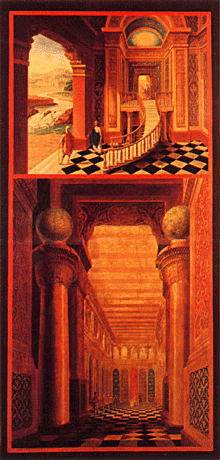 |
| |
Tracing Board for 2nd Degree. |
The second degree tracing board directly reflects part of the Solomonic legend. It depicts the entrance to King Solomon’s Temple, flanked by two pillars, terrestrial and celestial. Within the Temple is a winding staircase comprising three, five, and seven or more steps: three denoting the Master of the Lodge and the two Wardens; five denoting the five senses and also the five noble orders of architecture, which are the Tuscan, Doric, Ionic, Corinthian, and Composite; and seven denoting the liberal arts and sciences, namely grammar, rhetoric, logic, arithmetic, geometry, music, and astronomy.
This staircase leads, on the upper level, to the middle chamber of the Temple, where the Fellow Craftsmen went to receive their wages, and is allegorically the halfway point towards unity with the Divine. Indeed, above the open door of the Middle Chamber we can clearly see the Tetragrammaton, the biblical four-lettered name of God: yod, heh, waw, heh (יהוה).
The staircase turns through an angle of ninety degrees, which is important on two levels. Ninety degrees is of course a square angle, and the square is an ever-present symbol in Freemasonry. Moreoever, turning through ninety degrees as the Craftsman ascends allows him to view the surrounding objects from different angles, underscoring one principal aspect of Freemasonry: to decode the allegory of a given symbol, we need to regard that symbol from different angles, physically and figuratively.
The Third Degree
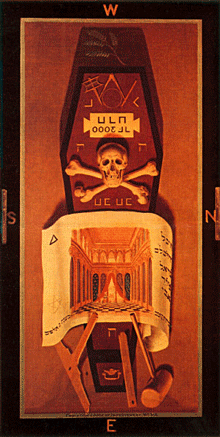 |
|
| Tracing Board for 3rd Degree. |
The third degree is often regarded as the true initiation. At its core, it deals with emergence from darkness to light, from life through death to rebirth, from ignorance to knowledge, from chaos to order, from despair to hope and joy. It also deals with strong bonds of true fraternity, interdependency, and love.
When the aspirant—now a Fellow Craft Freemason—is admitted to the third degree, all is in darkness. Unlike the first degree, where the aspirant was the only one in darkness due to his blindfold, here all the brethren are in darkness, except for a very faint light in the east at the Master’s pedestal. This is to emphasize that all the brethren need to take part in the ceremony to come; the Fellow Craftsman will need all the energy, all the support that he can get.
Under the care and protection of the Deacon, the Fellow Craft now perambulates the lodge in the same way as in the two preceding degrees. When that has been accomplished, he finds himself standing in the west, facing the glimmering light across the floor of the lodge. He needs to progress towards the light, literally as well as symbolically. But at his feet he may be able to see that he is standing on the brink of a grave. In order to approach light, therefore, he has to traverse the very negation of light and life, namely the ultimate symbol of death. Should he not succeed in negotiating this perilous path, the light will not be attainable. The grave over which he steps is not the grave destined to contain his own dead body, but rather the one where his own lower self now lies buried, and over which he has to walk before attaining the heights toward which he is now well advanced. Self-sacrifice and self-negation are essential before the candidate can be raised to a higher plane.
The Deacon instructs the candidate to step over the grave with three steps, from one side to the other and back again. After this, still under the guidance of the Deacon, he approaches the Master and the glimmering light; he kneels and swears a further vow, after which the Master creates, receives, and constitutes him a Master Mason. He then raises the candidate up to a standing position. Remember that all is still in nearly total darkness.
A little drama is then enacted, recounting the death of Hiram Abiff, in Masonic lore the principal architect of King Solomon’s Temple, in which three disenchanted craftsmen seek to obtain the secrets of the third degree from Hiram, threatening him with death if he refuses to communicate them. Hiram exhorts them to work hard at their task of building so that in time they may earn the right to those secrets, but it is to no avail, and Hiram is slain. The newly made Master Mason in this ceremony is made to play the part of Hiram, and when he “dies,” he is laid down onto the emblem of the grave which he earlier traversed on his journey towards light. A Masonic writer, Colin Dyer, once wrote:
As the Master was present in the lodge, his light remained, as the spiritual and moral teaching which he gave would still be with a Brother at the time of death, although those grand luminaries, the sun and moon, would no longer be of use to him. By the help of this teaching, he would triumph over death and succeed to life eternal, symbolised not only by the raising itself, but by the restoration of general light to the lodge.
Two attempts, summarizing the signs and words of the first two degrees, fail to raise Hiram from his death, but the Master of the Lodge tries a third way, which is successful. The Master now addresses the new Master Mason:
Let me now beg you to observe that the Light of a Master Mason is but darkness—visible; the darkness symbolises that mysterious veil which the eye of human reason cannot penetrate unless assisted by the Light which is from above.
These words, originally written during the Age of Enlightenment, are interesting in that, although human reason was regarded by the Enlightenment as practically sacrosanct, due observance is still paid to the power of the Divine in assisting us to penetrate the veil separating us from knowledge of our own true nature: as a divine spirit which happens to inhabit a human body.
The Master continues:
Guide your reflections to that most interesting of all human studies, the inner meaning of life, the knowledge of yourself . . . continue to listen to the voice of nature, which bears witness that even in this perishable frame resides a vital and immortal principle.
The culmination of the degree is the communication by the Master to the new Master Mason of the five points of fellowship: fraternity, support, keeping another’s wants in mind;, respecting confidences, and defending another’s character. These are accomplished by an intimate embrace.
It will be remembered that in the second degree the Fellow Craft passes into the middle chamber of King Solomon’s Temple to receive his wages. From there, having been raised to the degree of Master Mason, he proceeds to the Sanctum Sanctorum, where he symbolically stands face to face with God. Therefore in the third degree tracing board, we see the porch to the Sanctum Sanctorum, the dormer window which gives it light, and the checkered pavement of the first degree.
At the top of the board we see a sprig of acacia, which was said to mark the initial burial place of Hiram Abiff, the working tools of the third degree, which are the skirret, pencil, and compasses. We see skull and crossbones as emblems of mortality, and a plumb rule, a level, and a heavy maul, which are said to be the implements with which Hiram was slain.
Whether by accident or design, the legend and symbolism of Freemasonry owes much to the ancient Mysteries, chief amongst them the Eleusinian and Mithraic. In the Eleusinian Mystery tradition, neophytes were initiated in stages, part of which consisted in wandering in the dark, confused and disoriented. Their subsequent purification parallels the removal of money and valuables from the Masonic aspirant before his initiation. Eleusinian initiates reported that the experience transformed them and removed the fear of death. The Eleusinian initiate was also promised benefits in the afterlife.
In the Mithraic tradition, the Mithraeum bears remarkable similarity to the Masonic Temple; both are earthly representations of the cosmos through which souls pass in their process of reincarnation or evolution. Both temples have vaulted ceilings lined with stars. The space is windowless, closed to the outside, or with strategic openings. The Mithraic temple, like the Masonic Temple, is a timeless place where mysteries are performed, members of the community are initiated, earthly matters are deliberated, and, ultimately, brotherhood among the brethren is forged. Both spaces are rectangular in form.
Mithraea often contained shallow depressions, where a coffin containing the body of the symbolically deceased brother was situated. Both Masonic and Mithraic initiations are preceded by the symbolic death of the aspirant, to be reborn leaving his profane life behind. In any case, to be initiated in either tradition, moral integrity is a must.
Another point in common between the two brotherhoods is the importance given to the gesture of shaking hands. An initiate into the mysteries of Mithras is known by the Greek term syndexios, meaning one who has exchanged the handshake. This gesture represents agreement and fraternity.
In Mithraism, the initiate undertakes not to communicate the mysteries that have been revealed during an initiation—it is Mithras himself who is the guarantor of the promises. The meaning of initiation, in both traditions, lies not in a set of actions, gestures and words, but in the experience itself, in the transformative effect of the ceremony on the aspirant.
Freemasonry remains to this day the greatest representative of a tradition, based on equality and fraternity, that binds its members together in a chain that stretches from the past and reaches into the future.
Julian Rees is a member of the International Order of Freemasonry for Men and Women, formerly known as Co-Masonry. He is the author of a number of works on Freemasonry, chief among them being More Light: Today’s Freemasonry for Men and Women and Tracing Boards of the Three Degrees in Craft Freemasonry Explained.
 As cooler breezes blow and the colors on our campus of the trees blaze its annual palette of reds, oranges, and yellows, we know the seasons are shifting and summer is in retreat. The festivities of the warmer months have faded, but the Theosophical teachings and programs continue. Fall is an energetic time of year at Olcott. The gardens are put to sleep, but the renewal of spirit continues, perhaps more subtly.
As cooler breezes blow and the colors on our campus of the trees blaze its annual palette of reds, oranges, and yellows, we know the seasons are shifting and summer is in retreat. The festivities of the warmer months have faded, but the Theosophical teachings and programs continue. Fall is an energetic time of year at Olcott. The gardens are put to sleep, but the renewal of spirit continues, perhaps more subtly.

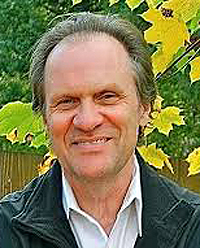 In the yogic traditions of the East, samadhi is a term used to describe a state of meditation variously defined as “transcendental consciousness,” “one-pointed absorption,” and “effortless concentration,” among other terms.
In the yogic traditions of the East, samadhi is a term used to describe a state of meditation variously defined as “transcendental consciousness,” “one-pointed absorption,” and “effortless concentration,” among other terms. On July 20, 1944, the second night of the Democratic National Convention in Chicago, Florida Senator Claude Pepper pushed through the sweltering crowd in an attempt to reach the podium. The event scripted by party leaders—the hostile replacement of the incumbent vice president on Franklin D. Roosevelt’s ticket with a more malleable senator from Missouri—was going off the rails. Progressive delegates chanted the name of the vice president, and Senator Pepper wanted to force a vote to save him while the crowd was hot. Seeing Pepper approach, and with gesticulating party insiders cajoling him to act, the convention chair brought down the gavel, ending the proceedings for the night.
On July 20, 1944, the second night of the Democratic National Convention in Chicago, Florida Senator Claude Pepper pushed through the sweltering crowd in an attempt to reach the podium. The event scripted by party leaders—the hostile replacement of the incumbent vice president on Franklin D. Roosevelt’s ticket with a more malleable senator from Missouri—was going off the rails. Progressive delegates chanted the name of the vice president, and Senator Pepper wanted to force a vote to save him while the crowd was hot. Seeing Pepper approach, and with gesticulating party insiders cajoling him to act, the convention chair brought down the gavel, ending the proceedings for the night.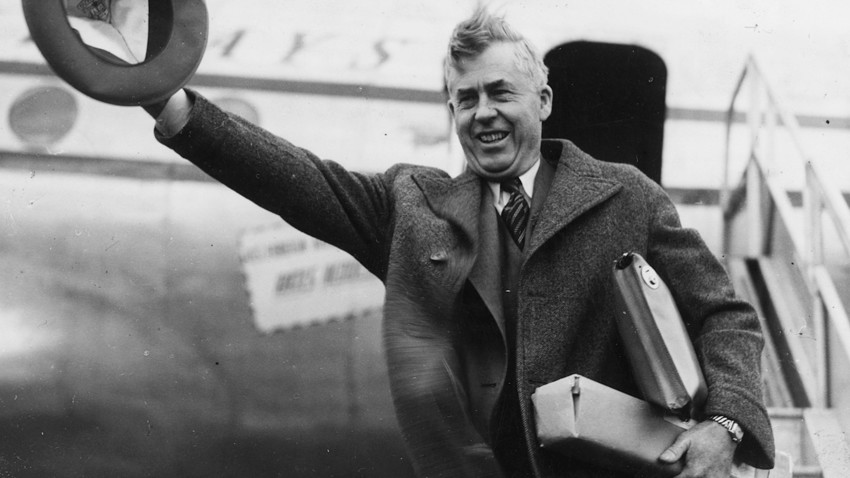 Henry Wallace (1888‒1965) was an unlikely politician. The vice presidency was the first and only office to which he was elected, and a decade before he rose to that office, few in Washington knew who he was. Wallace was an Iowa crop scientist and livestock breeder; seed and poultry companies he founded still thrive today. He was also the editor of an agriculture journal founded by his grandfather: Wallace’s Farmer, which is still being published under the title Wallaces Farmer. Wallace was blunt, long-winded, and had a tendency toward pomposity; he was not the sort who seemed likely to enter public life.
Henry Wallace (1888‒1965) was an unlikely politician. The vice presidency was the first and only office to which he was elected, and a decade before he rose to that office, few in Washington knew who he was. Wallace was an Iowa crop scientist and livestock breeder; seed and poultry companies he founded still thrive today. He was also the editor of an agriculture journal founded by his grandfather: Wallace’s Farmer, which is still being published under the title Wallaces Farmer. Wallace was blunt, long-winded, and had a tendency toward pomposity; he was not the sort who seemed likely to enter public life.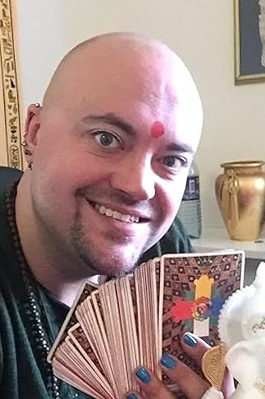 Freemasonry, or Masonry for short, is a fraternal order that is often considered to be shrouded in secrecy. Actually it is not a secret society, but is better described as a society that happens to have a few secrets. Masonry is a global spiritual brotherhood with long-held traditions and solid codes of ethics. It has had a lasting influence on both Western history and a wide array of esoteric systems.
Freemasonry, or Masonry for short, is a fraternal order that is often considered to be shrouded in secrecy. Actually it is not a secret society, but is better described as a society that happens to have a few secrets. Masonry is a global spiritual brotherhood with long-held traditions and solid codes of ethics. It has had a lasting influence on both Western history and a wide array of esoteric systems.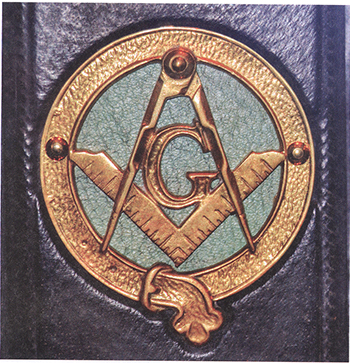 Some esoteric symbols within Freemasonry are strictly initiatory, while others are quite common. The square and compass is easily the best-known Masonic symbol and is found in all Masonic lodges around the world. The emblem is also common on virtually all “brotherly bling,” such as rings, necklaces, pocket watches, compasses, pocket knives, coins, and bumper stickers, and so on. It is also a popular tattoo!
Some esoteric symbols within Freemasonry are strictly initiatory, while others are quite common. The square and compass is easily the best-known Masonic symbol and is found in all Masonic lodges around the world. The emblem is also common on virtually all “brotherly bling,” such as rings, necklaces, pocket watches, compasses, pocket knives, coins, and bumper stickers, and so on. It is also a popular tattoo! What would you say if you knew there was a worldwide pursuit of nonreligious, secular spirituality over three hundred years old? It is called Freemasonry, a pursuit that has been wrongly characterized in many ways: as a rich men’s social club, as an excuse to dress up in elaborate regalia, as a sinister movement whose aim is worldwide domination, as a charitable foundation whose primary aim is the relief of distress, as a men-only organization acting as a refuge from marital encumbrances, and many more.
What would you say if you knew there was a worldwide pursuit of nonreligious, secular spirituality over three hundred years old? It is called Freemasonry, a pursuit that has been wrongly characterized in many ways: as a rich men’s social club, as an excuse to dress up in elaborate regalia, as a sinister movement whose aim is worldwide domination, as a charitable foundation whose primary aim is the relief of distress, as a men-only organization acting as a refuge from marital encumbrances, and many more.


